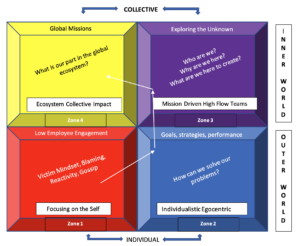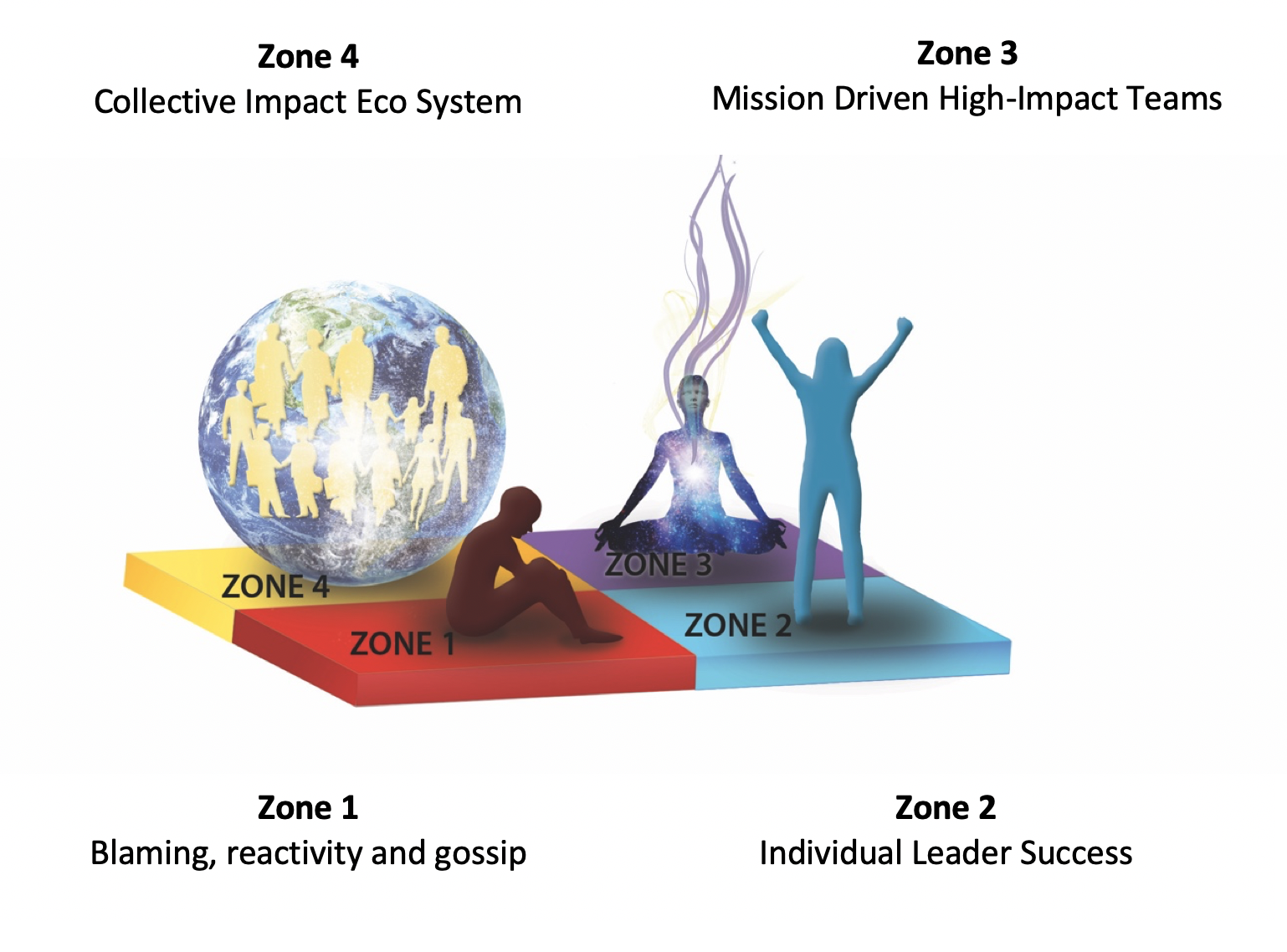An Evolutionary Leadership Framework
The 4 Zones of Leadership is an evolutionary leadership framework developed over 3 decades. A framework that emerged from Steven Ringelstein’s work as a CEO of high-tech companies, as well as years of working with hundreds business leaders of small to Fortune 500 companies.
This framework allows leaders, teams and organizations to transform destructive and undesirable behaviors to positive ones which result in extraordinary levels of performance and results.
Zone 1 – Focusing on the Self – fear based, blaming, reactivity, and gossip
In Zone 1 everything is about you, and it is fear based. When you are a leader operating in Zone 1, you experience a gap between reality (what is actually happening) and your imagined reality of expectations. When the expected reality is not met, you most likely go to negative thinking, blame yourself and others, become emotionally reactive and/or even gossip about it.
Let’s look at the 3 main behaviors in Zone 1:
- Frustration, disappointments, resentments followed by status-quo.
- Communication breakdowns, conflicts and silos across the organization.
- Culture that is fear based, complains, reacts and gossips.
Leaders, teams and organizations in Zone 1 account for low employee engagement, low performance and difficult cultures to work within. Zone 1 organizations typically emerge over time if the organization is not a learning and innovating organization. It also emerges after mergers, acquisitions and corporate restructuring that disrupts the working order and culture that was previously there.
While your organization might not have all of those characteristics, you might find aspects, behaviors and symptoms of a Zone 1 organization within your teams.
Zone 2 – Egocentric Values & Behaviors – personal responsibility, problem solving and learning
Leaders in Zone 2 tend to be egocentric – secretly asking, “what’s in it for me?” They are leaders who are willing to take personal responsibility for everything that happens in their lives and businesses. They practice with an open mind and are willing to learn new things. They are highly competitive and will do anything to rise to the top.
Some of the typical attitudes and behaviors in Zone 2 are:
- Individual agendas that are not necessarily aligned with others.
- What’s in it for me decision-making approach.
- On a quest for power, control and greater influence over others.
Although Zone 2 leadership is about having accountability and results, often the competition and need for personal gain can lead to unnecessary politics, bureaucracies and unintended consequences to stakeholders.
Zone 3 – Mission Driven, High Flow State Teams
If you are a leader in Zone 3 you have a high level of awareness of your Inner World. Your Inner World has to do with your thoughts, mental constructs, emotions, energy, perceptions, experience of reality, your beliefs and your world view. It has to do with your BEING and how that BEING is experiencing your life and business.
Your Outer World has to do with what you do in the world, your actions, your creations, and all of the physical manifestation that you bring about.
Consider that your Inner World will greatly impact your Outer World. Leaders who operate in high flow states have been trained to master their Inner World.
Little energy is spent on managing conflicts, misalignments and separate agendas you might have in Zone 2. This approach to leadership welcomes multiple perspectives and illuminates new possibilities.
In Zone 3, leaders, teams and organizations share a clarity on these Inner World questions:
- Who are we as a team and organization?
- Why are we here as a team and organization?
- What are we here to create as a team and as an organization?
In Zone 3, leaders are not afraid to try new things, make mistakes or embark into the unknown knowing that true possibility exists in what we do not know that we do not know. Leaders in Zone 3 are willing to go beyond their thinking mind and use their innate imagination and intuition individually and collectively. Leaders in Zone 3 understand the power of integrating many different perspectives to create the unimaginable. They know that working alone they can work fast but working with a team they can get much further.
Zone 4 – Ecosystem Collective Impact
In Zone 4, there is an awareness of our Ecosystem’s collective intelligence, our Oneness, and the Inter-connectedness of our teams, organization, humanity as a whole, the animals and our planet. This is the Ecosystem perspective to your business and to the collective impact that your organization can make.
In Zone 4 leaders ask the following questions:
- How does our organizational mission align with even greater missions in the world?
- Who can we partner with our Ecosystem stakeholders to create greater collective impact?
- What can we learn from the emerging ecosystem to inform how to innovate our company, products and services?
Zone 4 leadership allows organizations to collaborate on bigger projects than their own and align their organization with the ecosystem trends, emerging new market forces and the arising future.


